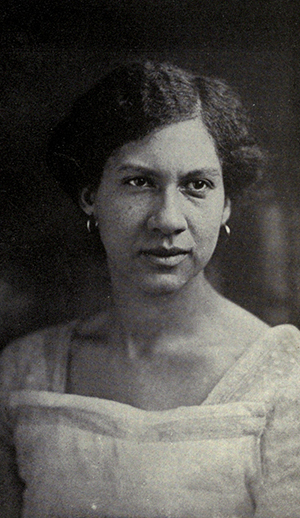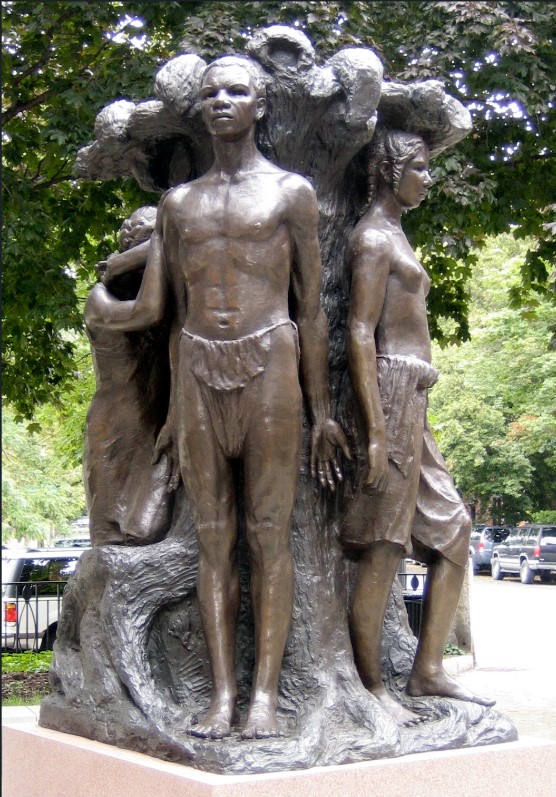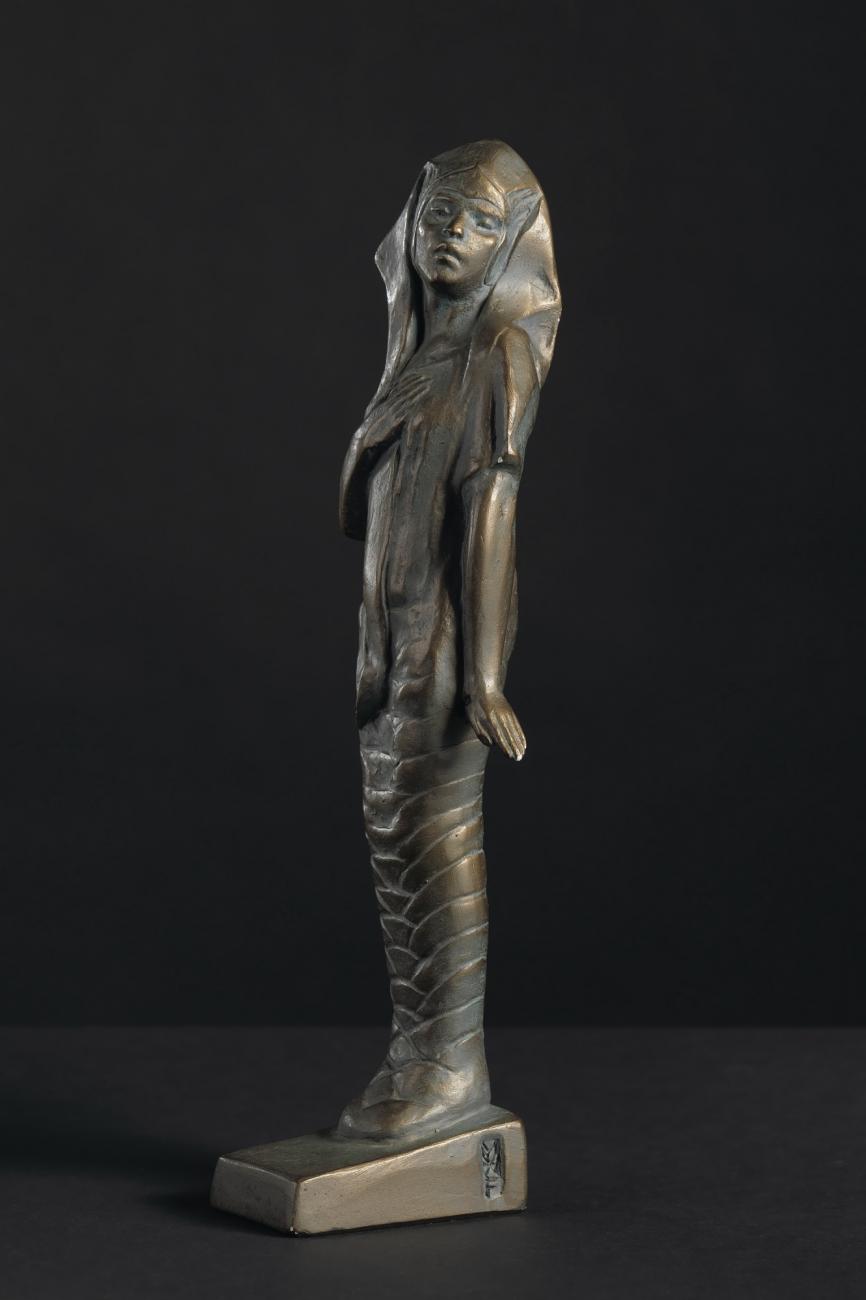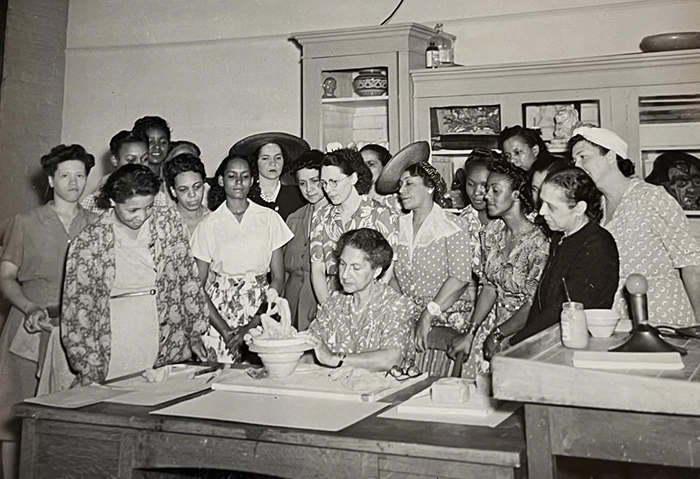Shaping the Public Imagination: The Sculpture of Meta Vaux Warrick Fuller
by Chenoa Baker
 Meta Vaux Warrick Fuller (b. Philadelphia, 1877–d. Massachusetts, 1968) was a clay, plaster, and bronze sculptor, born to upper middle-class parents working in the hair industry in Philadelphia. During the year, she spent time in Philadelphia but would go up to Martha’s Vineyard for summers with her childhood friend Lois Mailou Jones, who would also become an artist.[1] In her hometown, Fuller took classes at Philadelphia’s Public Industrial School near her home at 254 S. 12th Street, in the area known today as the Gayborhood.[2]
Meta Vaux Warrick Fuller (b. Philadelphia, 1877–d. Massachusetts, 1968) was a clay, plaster, and bronze sculptor, born to upper middle-class parents working in the hair industry in Philadelphia. During the year, she spent time in Philadelphia but would go up to Martha’s Vineyard for summers with her childhood friend Lois Mailou Jones, who would also become an artist.[1] In her hometown, Fuller took classes at Philadelphia’s Public Industrial School near her home at 254 S. 12th Street, in the area known today as the Gayborhood.[2]
At sixteen, already showing amazing talent, Fuller took one of her wood-carved sculptures to the 1893 World’s Columbian Exposition in Chicago (only twenty-eight years after the Civil War ended enslavement). Twenty-seven million people saw her work throughout the Exposition’s six-month run.[3] This was an amazing feat for a teenager, and it foreshadowed other high points in her career in the creation of public art.
After the Exposition, she attended the Pennsylvania Museum School of Industrial Arts (later known as the Philadelphia College of Art, then as the University of the Arts, which closed in 2024). Her public artworks and theater set designs for her church preceded the boom of the Harlem Renaissance. She took up self-portraiture and historical subject matter, embraced the styles of Neoclassicism and Egyptian Revivalism, and explored the aesthetic languages en vogue at the time. However, no matter the style, her experiences began radicalizing her. In 1897 her father died, and she grieved through her work. In 1899 she moved to Paris where she experienced racism.[4] Three years later, when she returned to the US, she faced further rejection as an artist due to race. This pushed her to capture various human emotions and suffering in her sculptures. W. E. B. Du Bois strongly encouraged her to create works that advanced the race, and he commissioned specific pieces with that subject matter.
In 1900, while Fuller was living in France, the Paris Exposition Universelle was held. For this fair, Du Bois organized the American Negro exhibit in the Palace of Social Economy.[5] He connected with Fuller and invited her to participate in the American Negro exhibit, which chronicled African American achievements from 1877 to 1900. Du Bois wanted to highlight intellectual successes such as the Cotton States and International Exposition in Atlanta of 1895, at which Booker T. Washington famously gave a speech on racial advancement, which is often pejoratively called the Atlanta Compromise.
In 1903, the same year the ceramics program at the Philadelphia College of Art was established, Fuller won an award for a ceramic vessel she made. At the time, she also took classes at the Pennsylvania Academy of Fine Arts (PAFA). Her work was shown with pieces by prominent artists including Mary Cassatt and Thomas Eakins.[6] She kept up with Auguste Rodin, who supported her practice and was astounded by her work in Paris.
Thomas J. Calloway, an associate of Du Bois’s who worked on the Negro exhibit in 1900 and met Fuller in Paris, recommended her for the opportunity to showcase her work at the Jamestown Tercentennial Exposition of 1907 in Norfolk, Virginia. In this moment, Fuller became the first Black woman to obtain a federal commission. She made $1800, which is equivalent to $47,000 today.[7] The Exposition, which marked the three hundredth anniversary of the English settlement in Jamestown, Virginia, was a high point in her career. She created a diorama displaying 150 plaster figures that dramatized the history of African Americans since their arrival in Jamestown.[8] Departing from one-sided fantasies of colonization, Fuller reactivated the horror of the period of settlement and honored African descendant people in her work.
To mark the colonial moment that ruptured North America in perpetuity, Fuller drew upon modes of display that were used in industrial and craft expositions of the late 1800s and early 1900s. Dioramas were didactic, experiential, and large-scale, and, to that point, were created exclusively by White men. Upon displaying her diorama at the 1907 Jamestown Exposition, Fuller’s performance was gendered, raced, and classed—almost like she was the “poster child” of Du Bois’s Talented Tenth, which likely brought up mixed feelings for her. Although she contributed a major work to the exposition, Fuller, as a Black woman, was able to engage with her audience in only a limited way.
 After the 1907 Tricentennial, Meta won a gold medal from the Federal Government Commission in Fine Arts. In 1909 she married a Liberian man, Solomon C. Fuller.[9] Many pieces that were part of her Jamestown diorama were lost in a fire in Philadelphia in 1910.
After the 1907 Tricentennial, Meta won a gold medal from the Federal Government Commission in Fine Arts. In 1909 she married a Liberian man, Solomon C. Fuller.[9] Many pieces that were part of her Jamestown diorama were lost in a fire in Philadelphia in 1910.
More than a century later, at the 2022 Venice Biennale, the artist Simone Leigh, like Fuller, showed layers of history in her work, in this case by juxtaposing American colonial–style façades and pre-colonial West and Central African–inspired architecture.[10] I cannot help but recognize the connective tissue between Fuller and Leigh, despite their being decades apart.
Some of Fuller’s other well-known artworks, not connected to a national exposition, are Secret Sorrow/Man Eating His Own Heart (1900); The Wretched (1902), which garnered her the title “sculptor of horrors”; Emancipation (1913), located in Harriet Tubman Park in Boston’s South End (which I’ve passed by in awe); Ethiopia/Ethiopia Awakening (1921); Talking Skull (1939); Storytime (1961); and Crucifixion (1963). Her scrapbooks and diaries, held in Framingham State University’s collection at the Danforth Art Museum, have recently resurfaced, as have early works like Reverie (n.d.).[11] Fuller’s early works are abstract and evocative, ranging from smooth to highly textured, and reflect what was going on in her personal life and the world. She wrote, “[I] sculpt the soul as opposed to the figure.”[12] One of her great sculptures, Emancipation, has been praised for countering traditional narratives of emancipation that give agency to White people rather than to Black people, who, in Fuller’s piece, emerge from the Tree of Knowledge. This work was originally made for the 1913 National Emancipation Exposition, celebrating the fiftieth anniversary of emancipation.[13]
 Ethiopia/Ethiopia Awakening is Fuller’s most famous sculpture. It depicts a graceful figure in a shendyt (wrapped skirt with pleats that indicate a higher status) and a Nemeš headdress. This piece emerged from the Egyptian Revivalism of the 1920s following the “discovery” of King Tutankhamun’s tomb by Europeans, the acknowledgement of Ethiopia being the only country in Africa not to be colonized, and the growth of the Ethiopia Movement, a Black Nationalist movement led by women who were followers of Marcus Garvey until he was deported in 1927. Artists such as Fuller kept internationalist politics in circulation.
Ethiopia/Ethiopia Awakening is Fuller’s most famous sculpture. It depicts a graceful figure in a shendyt (wrapped skirt with pleats that indicate a higher status) and a Nemeš headdress. This piece emerged from the Egyptian Revivalism of the 1920s following the “discovery” of King Tutankhamun’s tomb by Europeans, the acknowledgement of Ethiopia being the only country in Africa not to be colonized, and the growth of the Ethiopia Movement, a Black Nationalist movement led by women who were followers of Marcus Garvey until he was deported in 1927. Artists such as Fuller kept internationalist politics in circulation.
In many ways, I feel a kinship with Fuller. I now live in Philadelphia, previously lived in Massachusetts for a few years, and am a sculptor. Fuller was one of the most important artists of the late nineteenth and early twentieth centuries because of how prolific she was and how deeply she shaped the public imagination through national expositions. In her more than seventy-year career, she traced the arc of art movements from 1890 to 1963 through a unique lens. Her historical vision makes me wonder what works she might have created in response to the upcoming 250th anniversary of the Declaration of Independence.

For further reading, please see Renée Ater’s Remaking Race and History: The Sculpture of Meta Warrick Fuller (University of California Press, 2011).
Chenoa Baker is a curator, writer, and descendant of self-emancipators. She was an adjunct at the Massachusetts College of Art and Design and a consultant on Touching Roots: Black Ancestral Legacies in the Americas at MFA/Boston. In 2023, she received the Association Internationale des Critiques d’Art (AICA) Young Art Critics Prize. She currently teaches African American Craft History at the James Renwick Alliance and writes for various publications, including The Brooklyn Rail.
[1] Lisa Farrington, “Meta Warrick Fuller,” African-American Art: A Visual and Cultural History (Oxford, UK: Oxford University Press, 2017). 121–123.
[2] “Ep. 3: Courtroom of the Dolls & the Sculptor of Horrors,” My Favorite Feminists, February 10, 2019. https://podcasts.apple.com/us/podcast/ep-3-courtroom-of-the-dolls-the-sculptor-of-horrors/id1449387311?i=1000429591385.
[3] Rebekah Coffman, “The Souvenirs and Stories of the 1893 World’s Columbian Exposition,” The Chicago History Museum, 2023. https://www.chicagohistory.org/the-souvenirs-and-stories-of-the-1893-worlds-columbian-exposition/#:~:text=Open%20from%20May%201%20through,never%2Dbefore%2Dseen%20scale.
[4] “Ep. 3: Courtroom of the Dolls & the Sculptor of Horrors,” My Favorite Feminists, February 10, 2019. https://podcasts.apple.com/us/podcast/ep-3-courtroom-of-the-dolls-the-sculptor-of-horrors/id1449387311?i=1000429591385.
[5] Kelli Morgan, “First-Person Institutions,” Adding Voices Conference, Moore College of Art and Design, Philadelphia, PA, November 9, 2024.
[6] “Ep. 3: Courtroom of the Dolls & the Sculptor of Horrors,” My Favorite Feminists, February 10, 2019. https://podcasts.apple.com/us/podcast/ep-3-courtroom-of-the-dolls-the-sculptor-of-horrors/id1449387311?i=1000429591385.
[7] “Ep. 3: Courtroom of the Dolls & the Sculptor of Horrors,” My Favorite Feminists, February 10, 2019. https://podcasts.apple.com/us/podcast/ep-3-courtroom-of-the-dolls-the-sculptor-of-horrors/id1449387311?i=1000429591385.
[8] “SMNTY Classics: Meta Vaux Warrick Fuller,” Stuff Mom Never Told You, February 16, 2023. https://www.podgist.com/vip/transcript?sid=0ba837cd-519a-46a1-b252-cb9bf503664c&pid=b0eb4a72-2ec8-4497-ad65-0d27295ec82f.
[9] “SMNTY Classics: Meta Vaux Warrick Fuller,” Stuff Mom Never Told You, February 16, 2023. https://www.podgist.com/vip/transcript?sid=0ba837cd-519a-46a1-b252-cb9bf503664c&pid=b0eb4a72-2ec8-4497-ad65-0d27295ec82f.
[10] “Sovereignty,” Simone Leigh: Sovereignty, Institute of Contemporary Art, Boston, 2022. https://simoneleighvenice2022.org/sovereignty/.
[11] “In the Studio: The Meta Vaux Warrick Fuller Collection,” Danforth Art Museum, Framingham State University, permanently on view. https://danforth.framingham.edu/exhibition/meta-fuller/.
[12] “SMNTY Classics: Meta Vaux Warrick Fuller,” Stuff Mom Never Told You, February 16, 2023. https://www.podgist.com/vip/transcript?sid=0ba837cd-519a-46a1-b252-cb9bf503664c&pid=b0eb4a72-2ec8-4497-ad65-0d27295ec82f.
[13] “Juneteenth Lesson: Emancipation Through the Art of Meta Warrick Fuller,” Danforth Art Museum, Framingham State University, 2021. https://danforth.framingham.edu/wp-content/uploads/2021/05/Juneteenth-Lesson.pdf.









































































